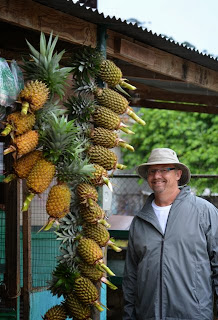In keeping the blog as an all encompassing travelogue of our adventures, I noticed that I have pictures and beginning commentary on Chuuk that has net yet been posted. I will post this now, beginning with a over view and history of Micronesia.
The history of the Federated States of Micronesia dates back several thousand years. The first settlers are thought to have migrated eastward from Southeast Asia to Yap. They are often described as Austronesian speakers who possessed horticultural skills and highly sophisticated maritime knowledge. The Lelu ruins in Kosrae (1400 AD) and the Nan Madol ruins of Pohnpei (1000 AD) are impressive reminders of the accomplishments of these early peoples.
Although the islands were spotted as early as the 1500s by Spanish, Portugese and English explorers, they remained uncolonized until the 19th century, when Spain took control. Spain established its colonial government on Yap and claimed sovereignty over the islands until 1899, when it sold them to Germany.
German administration encouraged the development of trade and production of copra. However, in 1914 the Japanese took over the islands after the Germans virtually abandoned them to bring their ships back to the war in Europe. During this period, extensive settlement resulted in a Japanese population of more than 100,000 throughout Micronesia. The indigenous population was then about 40,000. Sugarcane, mining, fishing and tropical agriculture became the major industries.
World War II brought an abrupt end to the relative prosperity experienced during Japanese civil administration. By the war's conclusion most infrastructure had been laid to waste by bombing. The islands and people had been exploited by the Japanese military to the point of impoverishment. With Japan's defeat in World War II, the islands became U.N. Trust Territories, administered by the U.S. In 1978, the Federated States of Micronesia began to emerge from trusteeship. The country became self-governing in 1986 and became a member of the United Nations in 1991.
The islands are striving, under close financial scrutiny from the U.S., to establish an independent economy. Most have developed well, although Chuuk has had huge financial problems.
Our day here was a bucket raining day - which does not help in that in their financial struggles has kept the roads from being paved - we therefore had to wade in ankle deep puddles watching one lane (two way) directed traffic. So why are we here, well Chuuk, with its vast, shallow, beautiful lagoon is a Mecca for wreck divers. A major shipwreck site from WWII, Truk Lagoon is unquestionably the world's best shipwreck diving destination. The Fujikawa Maru is often singled out by diving magazines and travel guides as one of the top 10 wreck dives in the world. However, apart from scuba diving, there is not very much to do in Chuuk. There are no real beaches on Weno (although some of the outer islands which can be reached by boat do have beaches). None of the hotels on Chuuk even has a swimming pool. So for us it is a remote pin on our travel map to mark a spot that not many get to, so tick, we have been to Micronesia. Some pictures of our time here over a month ago. BTW. one of the biggest Spam displays we have ever seen, ah, yes Spam.





























No comments:
Post a Comment